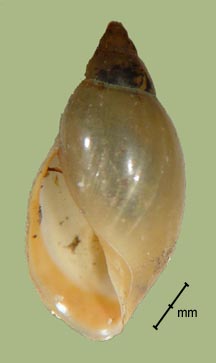> Habitat & Distribution
Physa carolinae is seasonally common in shallow, temporary, or vernal ponds and ditches in the lower Piedmont and Coastal Plain of southern Atlantic and Gulf drainages, extending as far north as Delaware and Maryland and south to Florida. It apparently grazes on organic debris and detritus when the ponds fill with rainwater, and burrows as the ponds dry. In habitat, life history, and shell form it is reminiscent of the northern physid genus Aplexa. FWGNA incidence rank I-4.
> Ecology & Life History
Our laboratory cultures reach maturity around 7 9 weeks post hatch, about a week later than typical P. acuta and much behind P. pomilia. Although Physa carolinae reaches a greater maximum size than either of the other two South Carolina Physa species, its fecundity in laboratory culture is lower.
> Taxonomy & Systematics
Populations of P. carolinae can typically be recognized by their dark bodies and slender shells. Dillon and Jacquemin (2015) reported that the larger adult size and slender, more fusiform shell morphology by which populations of P. carolinae may be distinguished is highly heritable. See my essay of 15Apr15 from the link below for more.
This species has probably been confused both with P. acuta and with P. pomilia (or hendersoni) throughout their broadly-overlapping ranges. DNA sequence data first called the distinction to our attention (Wethington & Lydeard 2007), which we subsequently confirmed with breeding experiments (Dillon 2009). Populations of P. carolinae freely hybridize with P. acuta, but F1 hybrids are sterile. Physa carolinae and P. pomilia demonstrate significant sexual isolation when paired in mate-choice tests, by contrast, and carolinae/pomilia hybrids are apparently inviable. We previously referred to this taxon as "Physa species A." Read all about our adventures along the exciting path toward the discovery of P. carolinae in my blog post of 7Apr10.
For notes regarding generic placement of this and other physid species of the American southeast, see my essay of 12Oct07.
> Maps and Supplementary Resources
- Physa carolinae distribution in Atlantic drainages (2023)
- Physa distribution in Georgia and the Florida panhandle (2025)
- Virginia species account with county distribution (2011)
- The discovery of Physa carolinae was featured in a YouTube video produced by The College of Charleston in 2010. Yours truly appeared in a supporting role.
> Essays
- The phylogenetic analysis of Wethington & Lydeard prompted me to review The Classification of the Physidae in my post of 12Oct07.
- The discovery of Physa carolinae was featured in my post to the FWGNA blog on 7Apr10, "TRUE CONFESSIONS: I described a new species." Additional photos of the animal and its habitat are available as well, and even (link way at the bottom) a video starring yours truly!
- The Dillon et al. (2011) paper on the evolution of reproductive isolation in Physa served as a jumping-off point for my blog post of 12July11, "What is a Species Tree?"
- For an historical perspective on the classification of the Physidae, see my three part series on the life and work of George A. Te: To Identify a Physa 1971, To Identify a Physa 1975, and To Identify a Physa 1978 plus the more personal To Identify a Physa 1989 and To Identify a Physa 2000.
- See my post of 26Sept14 for good, comparative figures illustrating "The egg masses of freshwater pulmonate snails."
- Here's an amazing fact, announced on 15Apr15: The heritability of shell morphology in Physa h^2 = 0.819!
> References
Dillon, R. T. (2009) Empirical estimates of reproductive isolation among the Physa species of South Carolina. The Nautilus 123: 276 - 281.
Dillon, R. T., Jr. and S. J. Jacquemin (2015) The heritability of shell morphometrics in the freshwater pulmonate gastropod Physa. PLoS ONE 10(4) e0121962. [PDF]
Dillon, R. T., J. D. Robinson, and A. R. Wethington (2007) Empirical estimates of reproductive isolation between the freshwater pulmonates Physa acuta, P. pomilia, and P. hendersoni. Malacologia 49: 283-292. [PDF]
Dillon, R. T., A. R. Wethington, and C. Lydeard (2011) The evolution of reproductive isolation in a simultaneous hermaphrodite, the freshwater snail Physa. BMC Evolutionary Biology 11:144. [PDF] [html]
Wethington, A. R. (2004a) Phylogeny, taxonomy, and evolution of reproductive isolation in Physa (Pulmonata: Physidae) Ph.D. dissertation, University of Alabama, Tuscaloosa.
Wethington, A. R. (2004b) Family Physidae. A supplement to the workbook accompanying the FMCS Freshwater Identification Workshop, University of Alabama, Tuscaloosa. 24 pp. [PDF]
Wethington, A. R. & C. Lydeard (2007) A molecular phylogeny of Physidae (Gastropoda: Basommatophora) based on mitochondrial DNA sequences. J. Molluscan Stud. 73: 241 - 257. [PDF]
Wethington, A.R., J. Wise & R. T. Dillon, Jr. (2009) Genetic and morphological characterization of the Physidae of South Carolina, with description of a new species. Nautilus 123: 282-292. [PDF]








